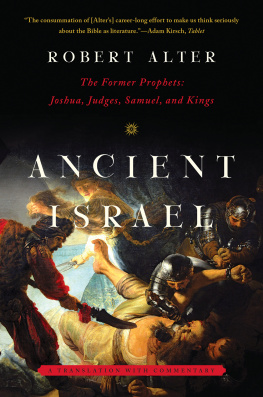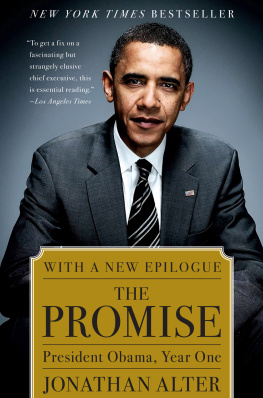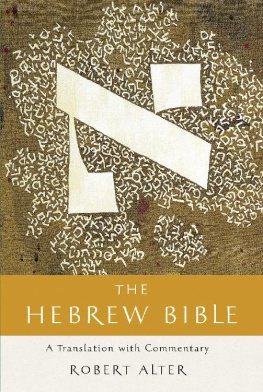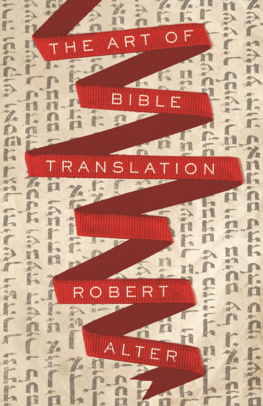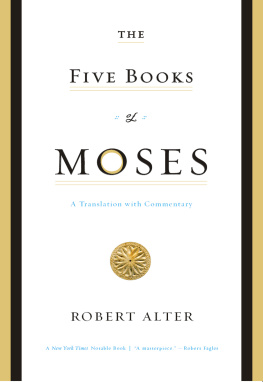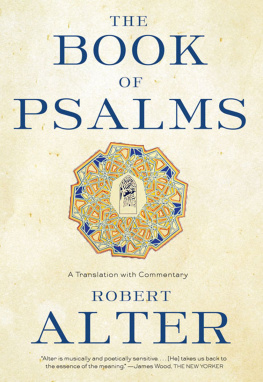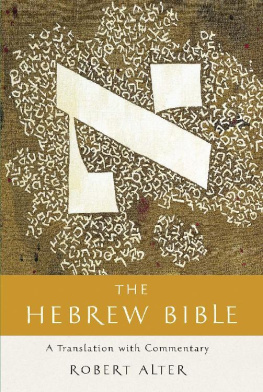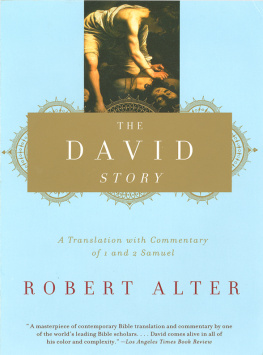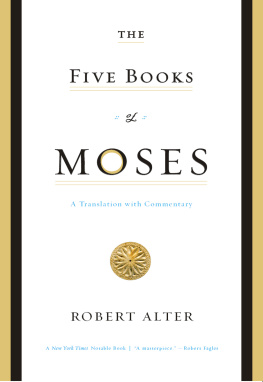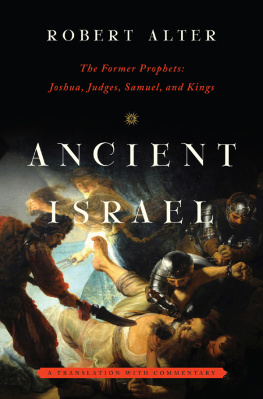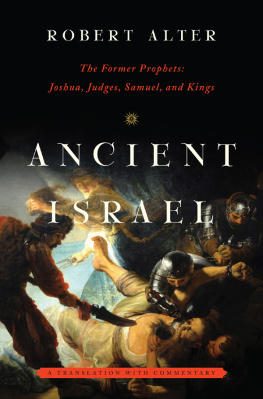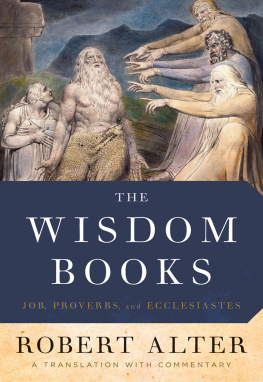
ANCIENT ISRAEL
THE FORMER PROPHETS:
JOSHUA, JUDGES, SAMUEL,
AND KINGS
A Translation with Commentary
ROBERT ALTER

for
HADAS
CONTENTS

T O MANY READERS, the rubric The Former Prophets may be puzzling. Some will not recognize it as the designation of a part of the Bible with which they are familiar. Some will wonder which prophets are involved, for the figures we usually think of as prophets like Jeremiah and Ezekiel are nowhere in evidence, and Isaiah has only a late walk-on appearance toward the end of 2 Kings. Then, the question poses itself: Former to what? Or even, what did they do after they stopped being prophets?
This conventional English title is a literal translation of the Hebrew neviim rishonim . In the canonical Hebrew division of the Bible into three parts, neviim , the Prophets, was the middle section. This large unit comprised two halves, the Former Prophets, which were narrative books, and the Latter Prophets, which were hortatory and predominantly poetic. The founders of Jewish tradition seem to have thought of the first of these two units as prophetic literature because they imagined it as having been composed by various of the so-called writing prophets. This is not a view in any way embraced by modern scholarship. More plausible grounds for calling this sequence of narratives the Former Prophets is that from Samuel onward figures identified as prophets keep popping up, for the most part to frame the narrative with prophecies of doom. (This is not true for Joshua and Judges. The sole exception is Deborah in Judges 4, who is called a prophet-woman, ishah neviah , but she is not shown exercising that vocation.)
Biblical scholars, since the work in Germany by Martin Noth in the middle of the twentieth century, have adopted a more precise though less pronounceable designation for the large narrative from Joshua and Judges to Samuel and Kings: the Deuteronomistic History. In the late seventh century BCE, a major revolution in the religion of ancient Israel was effected when, in the course of renovation work on the temple in the reign of King Josiah, a long scroll was purportedly discovered (see 2 Kings 2223), referred to as this book of teaching, sefer hatorah hazeh . Most scholars since the early nineteenth century have concluded that it was a version of Deuteronomy, and surmise that it was actually composed around this time by reformers in Josiahs court. It put forth a new insistence on the exclusivity of the cult in the Jerusalem temple, vehemently polemicized against the use of any image or icon in worship, and proposed a system of historical causation in which the survival of a given king and of the covenanted people was strictly dependent on their loyaltyabove all, cultic loyaltyto their God. All this was cast in language that highlighted certain formulaic phrasesto love the L ORD your God with all your heart and with all your might, to keep His statutes, His commands and His dictatesand in a distinctive rhetoric that, unlike other biblical prose, favored long periodic sentences and the oratorical insistence of anaphorathat is, emphatic repetition.
At the same time that Deuteronomy proper (which would acquire some additional layers when it was edited in the Babylonian exile only a few decades after its initial promulgation in 621 BCE) was exhorting the people to follow what it deemed to be the right path, writers in this same circle sought to make sense of the history of the nation in the revelatory light of the new reforming book. A religious intellectualit may actually have been a whole group, but for the sake of convenience, scholarship refers to him schematically as the Deuteronomistwho was swept up in Josiahs reforms set out to assemble a more or less continuous version of the national history from the conquest of the land to his own time, covering roughly six centuries. This first Deuteronomistic historian does not envisage the destruction of the southern kingdom (the northern kingdom of Israel had disappeared a century earlier, in 721 BCE, at the hands of the Assyrians) or of the cutting off of the Davidic dynasty, so it is plausible to date him to the late seventh century BCE. Then, in the view of most scholars, a second and more or less final edition of the Deuteronomistic History was executed in the Babylonian exile after 586 BCE, probably just a few decades later (it contains as yet no vision of a return to Zion), incorporating an account of the devastation of the kingdom of Judah and the humiliation, mutilation, and exile of its last king.
An elusive question about this entire chain of books is what exactly was the role played by the Deuteronomist in their composition. Some scholars are inclined to speak of him as the author of the history, a writer who utilized older textual and perhaps also oral materials but edited them and reworked them freely according to his own ideological bent. I find this view implausible. The Deuteronomist clearly drew on a wide variety of pre-existing texts, some of them probably preserved in royal archives, from annals to folktales and legends to the most artfully articulated historical narratives. He punctuated these disparate materials, especially in the Book of Kings, with formulaic assertionsoften reminiscent of the language of Deuteronomyof his own interpretation as to why particular historical events happened as they did. But there is abundant evidence that the old stories resisted the pressure of his insistent interpretation, showing their own view of things, and that for the most part he did not feel at liberty to tamper with the literary documents he had inherited.
Let me cite one central instance. Nearly a third of the Former Prophets is devoted to the story of Saul and David (1 Samuel 82 Kings 2). As a literary composition, this story manifestly antedates the Deuteronomist, perhaps even by as much as three centuries. It also happens to be one of the greatest pieces of narrative in all of Western literature. Biblical scholars have a lamentable habit of referring to it as royal propaganda, and also of breaking it down into purportedly disparate sources in a fashion that does violence to its powerful continuities of style, image, motif, and character. Though David is clearly represented as a divinely elected king in this narrative, he is also seen quite strikingly in all his human weakness, in his relentlessness, and in his moral ambiguityhardly a figure of royal propaganda. And in regard to the issue of historical causation, events here are the consequence of human actions; in the preponderance of these stories there is nothing miraculous and there is no divine intervention. When the aged king is dying, he calls Solomon to his bedside and instructs him to use his wisdom to get rid of two men against whom David has a score to pay off, and who also might well threaten Solomons throne. This final gesture, worthy of a mafia chieftain, was evidently too much for the Deuteronomist, so he inserted before Davids hit list a whole swatch of dialogue, in which David, deploying an uninterrupted pastiche of Deuteronomistic phrases, piously enjoins Solomon to walk in Gods ways and keep His commands. What the editor did not feel free to do was to change the inherited text or delete the parts of it he found objectionable.
This combination of tendentious editorial framing with an assemblage of disparate narrative texts from different periods and probably different regions of the country has been a source of debate and perplexity among scholars. General readers, on the other hand, may be grateful for the extravagant heterogeneity of these books. Each has its own distinctive character. The first half of Joshua is an account of conquest and destruction, enlivened by the tale of Rahab and the two spies and the fall of Jericho; the second half is a mapping out of the tribal territories in which the supposedly conquered land now appears far from fully conquered. The Book of Judges comprises a series of episodes of martial derring-do in the sundry struggles of the tribes with the surrounding peoples, and it includes the unforgettable cycle of stories about the Herculean folk-hero Samson. After the anarchic period recorded in Judges, Samuel recounts the founding of the monarchy in the long, continuous storywhich is the artistic pinnacle of these booksof David from brilliant youth to the sad infirmity of old age. It is in Samuel, as the German scholar Gerhard von Rad argued seven decades ago, that the writing becomes properly historical, liberated from the heavy dependence on legend and sheer authorial invention. The Book of Kings, in more miscellaneous fashion, and with more conspicuous interventions of the Deuteronomist, continues the historical narrative, tapping the royal annals of both kingdoms but also liberally introducing folktales and legends, especially visible in the cycle of stories about Elijah and Elisha.
Next page
